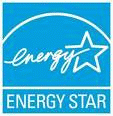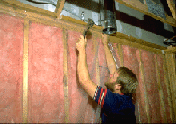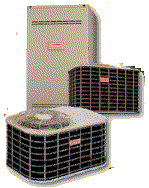 |
Las Vegas Energy Efficient Homes |
|
 |
Energy Efficient Homes in Las VegasThroughout the nation utility costs have risen dramatically in recent years and we are realizing that the monthly power and gas bills have become a significant part of our budget. When looking for a new home, an energy efficient building, although priced higher, might in fact result in a lower net monthly cost. There are even special types of mortgages that will cover the cost of upgrading the efficiency of a home. Trends in New ConstructionWith rising energy costs most Las Vegas builders are offering upgraded energy packages. Some builders even include the upgrades as standard. Of course this results in a slightly higher initial price but will probably result in a lower monthly operating cost. Some of the new trends are:
In addition to lower utility bills an energy efficient home is more comfortable and quiet. You will notice less drafts and increased air quality. The home and its contents will last longer and have a higher resale value. Like any other home improvement, there are costs and you will want to weigh these costs against the benefits. For example, spending $3,000 on a better performing air conditioner to save $10 a month on your power bill would probably not be a wise move. Adding solar screens may be the better choice. Energy ProgramsThere are a number of government programs affecting the housing market:
Windows
Most new homes these days windows consist of a frame made of vinyl or aluminum, with two sheets of glass (double-glazed) that are sometimes coated and separated with air or another gas such as argon. Double-glazed windows have a sealed space between two panes of glass to provide an added layer of insulation. Compared with a single pane, double-glazing can cut heat loss of the window nearly in half. A gas like argon will provide better thermal performance. Clear glass allows lots of heat to enter in the summer and heat to escape during the winter while low-E (low-emissivity) coatings add more insulation value to the window by blocking some heat from the sun. The materials used in the window frame can also affect energy efficiency. Vinyl is preferable to Aluminum but if you have chosen a vinyl frame be sure that it has welded corners for stability. The U-value is the measure of thermal performance. It describes a window's ability to conduct heat. The lower the U-factor the better the window. Look for double-glazing and a low-E coating. The U.S. Department of Energy recommends a U-value of 0.4 or less. Insulation
Studs used in construction of the exterior walls are typically 2 x 4 inch but you will find 2 x 6s used in the more energy efficient homes. The larger studs allow more space for more insulation. Heating and Cooling
Gas is the preferred heating fuel and electricity is used for air-conditioning. Air-conditioning efficiency is measured in SEER (Seasonal Energy Efficiency Ratio). The SEER is defined as the total cooling output (in Btu-British thermal units) provided by the unit during its normal annual usage period divided by its total energy input (in Watt-hours) during the same period. Currently 10-SEER is the standard but 12-SEER is becoming more common and will be the minimum standard by 2006. A programmable thermostat is the least costly component of a heating, ventilation and air conditioning (HVAC) system. By programming different temperatures while you are away at work and/or sleeping it can play a major role in your energy efficiency. Home Energy Rating System (HERS)A Home Energy Rating System is a program to rate the energy efficiency of a new or existing home and to estimate the annual energy costs associated with the home. A HERS inspector makes a physical examination of a home's hot water system, heating and cooling system and building envelope and generates a report listing possible energy improvements, and the amount of time it would take a homeowner to recover the cost of the improvements. Whether you are applying for an Energy Efficient Mortgage (EEM), Energy Improvement Loan, or are simply curious about the efficiency of your home, HERS inspectors are available. Costs run in the $250-450 range depending on the size of the home. Energy Inspectors are a local company available for HERS inspections. |
|
 represents a family of programs sponsored by the Department of Energy (DOE) and the Environmental Protection Agency (EPA) aimed at reducing energy consumption and associated air pollution. Products bearing the Energy Star label must show an efficiency 30% above 1993 standards.
represents a family of programs sponsored by the Department of Energy (DOE) and the Environmental Protection Agency (EPA) aimed at reducing energy consumption and associated air pollution. Products bearing the Energy Star label must show an efficiency 30% above 1993 standards.  In Las Vegas, power bills reach their peak during July and August when air conditioning units are working their hardest. If you are utilizing solar energy the sun can be your friend, but in most cases the heat entering through windows can be the most significant factor in your electrical bill. A nice shade tree can provide some protection but if you're moving into a newly constructed home that tree is now just the size of a buggy whip.
In Las Vegas, power bills reach their peak during July and August when air conditioning units are working their hardest. If you are utilizing solar energy the sun can be your friend, but in most cases the heat entering through windows can be the most significant factor in your electrical bill. A nice shade tree can provide some protection but if you're moving into a newly constructed home that tree is now just the size of a buggy whip. Insulation is measured in terms of resistance to heat flow; an R-factor. The higher the number the better. Builders describe their homes in terms of the R-factor in walls and a separate r-factor for ceilings or roof. A high efficiency home will have R-19 walls and R-30 ceilings. These numbers are usually an indication of the type of insulating batts that were placed in the wall or attic. Batts are typically thick pink fiberglass rolls that have been cut to fit between wall studs. Sometimes cellulose is blown into the wall cavities and attic instead of using batts. Another alterative is the use of an expanding polyurethane insulation. When it comes to filling areas around plumbing and electrical outlets, cellulose and polyurethane are preferable.
Insulation is measured in terms of resistance to heat flow; an R-factor. The higher the number the better. Builders describe their homes in terms of the R-factor in walls and a separate r-factor for ceilings or roof. A high efficiency home will have R-19 walls and R-30 ceilings. These numbers are usually an indication of the type of insulating batts that were placed in the wall or attic. Batts are typically thick pink fiberglass rolls that have been cut to fit between wall studs. Sometimes cellulose is blown into the wall cavities and attic instead of using batts. Another alterative is the use of an expanding polyurethane insulation. When it comes to filling areas around plumbing and electrical outlets, cellulose and polyurethane are preferable. There are two types of systems commonly found in Las Vegas... package and split. A package unit contains the air-conditioning and furnace all on one unit and is usually mounted on the roof. With this type of installation only the ductwork enters the home making it an ideal situation where space is at a premium. In a split system the furnace is located in the attic, garage or closet while the A/C sits outside.
There are two types of systems commonly found in Las Vegas... package and split. A package unit contains the air-conditioning and furnace all on one unit and is usually mounted on the roof. With this type of installation only the ductwork enters the home making it an ideal situation where space is at a premium. In a split system the furnace is located in the attic, garage or closet while the A/C sits outside.
